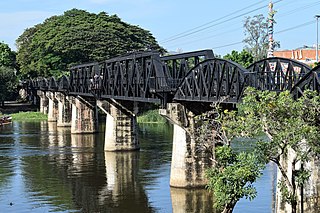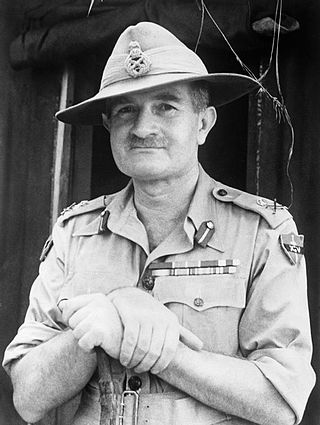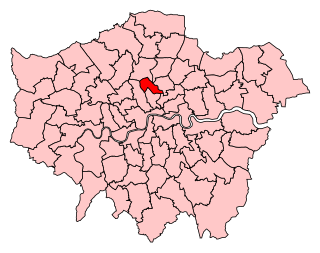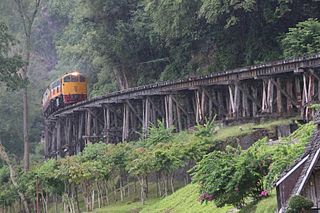
The Burma Railway, also known as the Siam–Burma Railway, Thai–Burma Railway and similar names, or as the Death Railway, is a 415 km (258 mi) railway between Ban Pong, Thailand and Thanbyuzayat, Burma. It was built from 1940 to 1943 by civilian laborers impressed or recruited by the Japanese and prisoners of war taken by the Japanese, to supply troops and weapons in the Burma campaign of World War II. It completed the rail link between Bangkok, Thailand, and Rangoon, Burma. The name used by the Japanese Government was Tai–Men Rensetsu Tetsudō (泰緬連接鉄道), which means Thailand-Burma-Link-Railway.

The London Borough of Islington is a London borough which forms part of Inner London. Islington has an estimated population of 215,667. It was formed in 1965 under the London Government Act 1963, which simultaneously abolished the metropolitan boroughs of Islington and Finsbury.

Holloway is an inner-city district of the London Borough of Islington, 3.3 miles (5.3 km) north of Charing Cross, which follows the line of the Holloway Road (A1). At the centre of Holloway is the Nag's Head commercial area which sits between the more residential Upper Holloway and Lower Holloway neighbourhoods. Holloway has a multicultural population. It is the home of Arsenal F.C., and was once home to the largest women's prison in Europe, Holloway Prison, until 2016. Prior to 1965, Holloway was in the historic county of Middlesex.

Field Marshal William Joseph Slim, 1st Viscount Slim,, usually known as Bill Slim, was a British military commander and the 13th Governor-General of Australia.

Islington was a civil parish and metropolitan borough in London, England. It was an ancient parish within the county of Middlesex, and formed part of The Metropolis from 1855. The parish was transferred to the County of London in 1889 and became a metropolitan borough in 1900. It was amalgamated with the Metropolitan Borough of Finsbury to form the London Borough of Islington in Greater London in 1965.

Islington North is a constituency in Greater London represented in the House of Commons of the UK Parliament since 1983 by Jeremy Corbyn, who was Leader of the Labour Party and Leader of the Opposition from 2015 to 2020.

St Pancras Old Church is a Church of England parish church in Somers Town, Central London. It is dedicated to the Roman martyr Saint Pancras, and is believed by many to be one of the oldest sites of Christian worship in England. The church is situated on Pancras Road in the London Borough of Camden, with the surrounding area and its international railway station taking its name. St Pancras Old Church, which was largely rebuilt in the Victorian era, should not be confused with St Pancras New Church (1819–1822) about 860 metres (940 yd) away, on Euston Road.

Highbury Fields is an open space in Highbury, in the London Borough of Islington. At 11.75 hectares, it is the largest open space in the borough.

Far East prisoners of war is a term used in the United Kingdom to describe former British and Commonwealth prisoners of war held in the Far East during the Second World War. The term is also used as the initialism FEPOW, or as the abbreviation Far East POWs.

The Australian War Memorial in London is a memorial dedicated in 2003 to the 102,000 Australian dead of the First and Second World Wars. It is located on the southernmost corner of Hyde Park Corner, on the traffic island that also houses the Wellington Arch, the New Zealand War Memorial, the Machine Gun Corps Memorial and the Royal Artillery Memorial.
Jack Bridger Chalker, was a British artist and teacher best known for his work recording the lives of the prisoners of war building the Burma Railway during World War II.

The Memorial Gates are a war memorial located at the Hyde Park Corner end of Constitution Hill in London. Also known as the Commonwealth Memorial Gates, they commemorate the armed forces of the British Empire from five regions of the Indian subcontinent, as well as Africa and the Caribbean, who served for Britain in the First and Second World Wars.
Keiko Holmes (恵子・ホームズ) is a Japanese coordinator for a charity named Agape, which helps to promote reconciliation between Japan and her former World War II prisoners of war (POWs). She lectures at universities and schools, and was awarded the O.B.E.
John George Mennie, A.R.M.S. D.A.(ABDN). ARMS., was a Scottish artist who came to public attention in 2011 for his many contemporaneous drawings of his life as a prisoner of war during the Japanese occupation of Singapore and Thailand in World War II. The drawings were made in secret depicting scenes of daily life and personalities in the camps in Singapore and Thailand, working on the Death railway. They also uniquely documented the Selarang Square Squeeze when some 17,000 prisoners were forced to crowd in the barracks square for nearly five days with little water and no sanitation until they signed a 'promise not to escape'.
Edwin Henry Horne was an English architect working in the Victorian era and best known for the six spacious new station buildings opened by the North London Railway between 1870 and 1872 to reflect the growing importance of the line."By E.H.Horne they were designed in a distinctive Venetian Gothic style not repeated elsewhere on the railways in England." His Camden Road Station, listed by Historic England, is one of the few suburban stations of the period to survive in London. A petition to Parliament to rebuild the 1872 facade of his Highbury & Islington station was lodged in 2015. In a career cut short at the age of 37, Horne's last major work was the heritage listed church, St John's Ealing.
Major Joseph Gordon Smith was a soldier who served with the 2nd Battalion of the Argyll and Sutherland Highlanders and the Royal Army Ordnance Corps. Smith served in Malaya during the Second World War and survived being held as a prisoner of war by the Japanese. During his imprisonment, Smith experienced many hardships and was forced to work on the Burma Railway, an experience which was illustrated by the film The Bridge on the River Kwai.

The statue of William Slim, 1st Viscount Slim in Whitehall, London, is a work of 1988–1993 by the sculptor Ivor Roberts-Jones. It is one of three memorials to British military leaders of World War II on Raleigh Green, outside the Ministry of Defence's Main Building, the others being Oscar Nemon's 1980 statue of Lord Montgomery and Roberts-Jones's statue of Lord Alanbrooke, erected later in 1993. Slim's bronze statue stands approximately 3 metres (9.8 ft) high on a pedestal of Portland stone.
Fergus Gordon Anckorn was a British soldier who, as starting as the conjurer Wizardus at age 18, was the longest-serving member of the Magic Circle.

The Wang Pho Viaduct, is a railway bridge made of wooden trestles which follow the cliff along the Khwae Noi River. The Wang Pho viaduct was constructed by allied prisoners of war of the Japanese during World War II as part of the Burma Railway. It is sometimes referred as the Double Viaduct, because of a nearby smaller viaduct. The viaduct is still in use and can be reached from the Wang Pho railway station.













